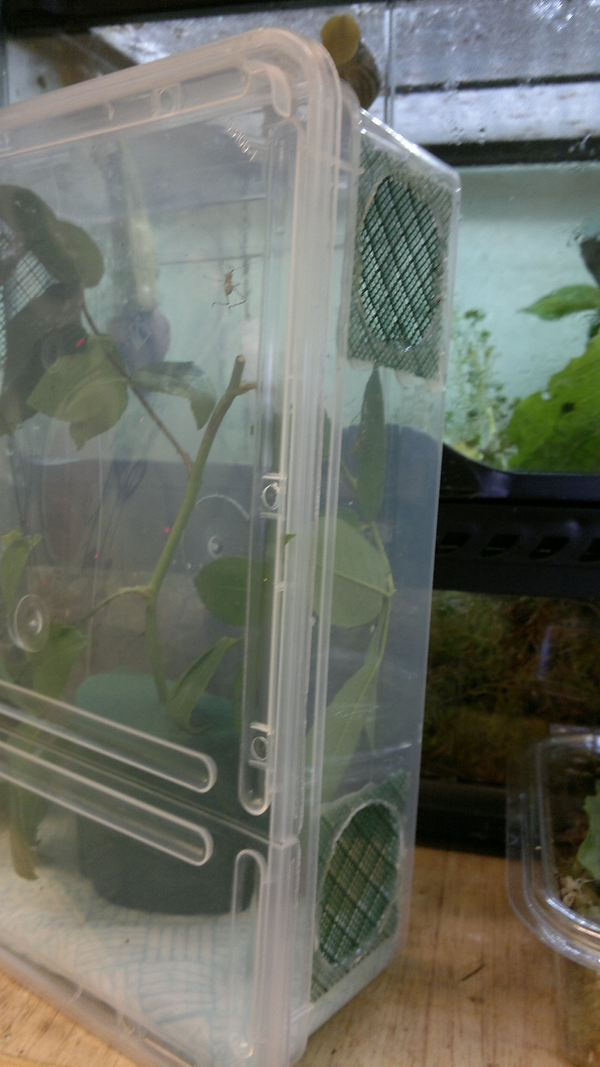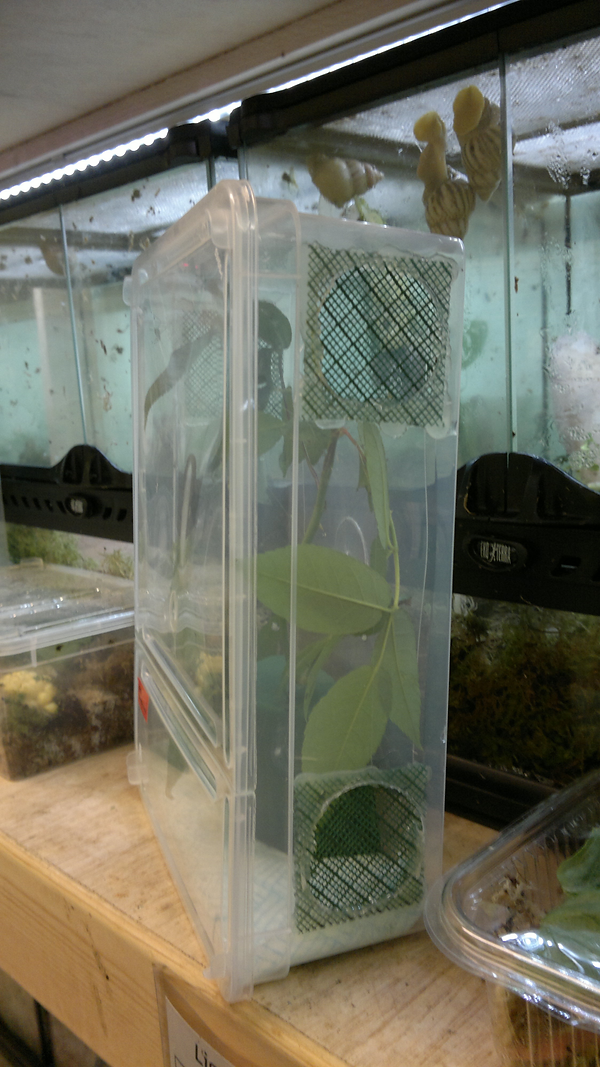Suitable Vivariums Photos :
Giant Texas Katydid molts
Entomica - BugOut - The Giant Malaysian Katydid
Things You'll Need :
-
Medium or large Kritter Keeper
-
Romaine Lettuce
-
Spray Bottle
-
Potting or Topsoil
-
Sticks, leaves, grass, and other natural decorations
Tips :
-
To tell the sex of your katydid look at the pictures below. A female katydid has a hook-like ovipositor on the back of the abdomen. The male lacks this reproductive organ.
-
If you're feeling confident you can handle you katydid. Be careful because they are very fragile. They can also jump and fly short distances so keep a close eye on your pet when it is outside the cage.
-
They do bite so watch out if you hold it for too long.
7-Enjoy your new pet: Your katydid will give you hours of entertainment as you watch it stalk, hop, and sing in its cage. You can enjoy the company of your new companion for 2 weeks - 3 months depending on the the katydid's age when you capture it.
6- Keep the tank moist: Using a spray bottle, lightly mist the tank every day.
5-Feed your new pet: Grocery shopping to feed you pet is easy and inexpensive. Give your katydid simple romaine lettuce and they will be happy for a long time. Remove spoiled food and refresh the lettuce daily.
4- Catch a Katydid: Unlike praying mantis or butterflies Katydids are not commonly available at online bug shops. Because of this the best way to acquire a katydid is to go on an insect hunt. During the hottest part of the day hunt for katydids in gardens, weedy areas with tall grasses, and crop fields.
3- Decorate the tank: Add leaves, branches, twigs, and any other decorations to make the home resemble the katydid's natural environment.
2- Add substrate to the tank: Potting soil or topsoil purchased from any home improvement store works perfectly. Fill the bottom of the tank with 2–3 inches (5.1–7.6 cm) of your chosen substrate.
1- Purchase a tank: Katydids require very little in terms of housing. A medium or large kritter keeper can safely house up to four katydids.
How to Take Care of a Katydid Insect
courtesy to : www.wikihow.com/Take-Care-of-a-Katydid-Insect
Driving near a field at night a person can expect to hear the chirping of crickets, cicadas, and the fascinating insect known as a katydid. These green bugs vaguely resemble grasshoppers with extremely long and skinny legs. They also come in many different shapes, colors or sizes. They are gentle creatures who, with a minimum amount of care, can be kept as an interesting pet.
Steps :
Breeding Giant Katydids :
It is not hard to breed Giant Katydids. You just need an adult couple, plenty of food, humidity and the proper temperature. When the environment is right for them, they will breed by themselves. The female will find a suitable branch for the eggs. She will first nibble on the branch to give it a rough coating, and then she will glue her eggs onto this. The eggs are laid on a long string, she can lay up to 100 to 150 eggs per batch!
It takes around 40 to 60 days for the eggs to hatch. The eggs need a lot of humitidy and a temperature of around 25 to 30 °C. The young nymphs are very fragile and can jump already pretty far. Keep them together in a big enclosure with plenty of light and fresh leaves. The air humidity is extremely important for nymphs, as low humidity will cause them to get stuck in their skin when molting. When molting from subadult to adult low air humidity will cause them to develop crooked and malformed wings.
Interested in other katydids? Check out our Ventralla Katydid page.
An adult Giant Katydid female seen from the front.
Food and feeding :
This species of katydid exclusively feeds of plants. It will eat leaves of oak, bramble, hazel, hypericum, butterfly bush (Buddleja), apple, rose and hawthorn.
You can keep the leaves fresh by cutting off branches and placing them in a cup of water. Be sure to cover up the water by leaves or a cloth if you have young nymphs, otherwise they could drown in the water.
An adult Giant Katydid female.
Enclosure for Giant Katydids
The enclosure for your Giant Katydids needs to be big enough to house them and their food. You need at least 30 cm in height, but more is always better. For one couple adult katydids you need around 30 x 30 x 30 cm or more, preferably double that size. The enclosure should be bigger if you house more than one adult couple or many nymphs.
The enclosure should be well ventilated by one or more mesh sides to it. You can also house them in an enclosure completely made of mesh or gauze to maximize ventilation. Keep the temperature at 25 to 30° C. The humidity should be high for this species; spray with water every day and make sure the substrate on the bottom of the enclosure stays moist. More about maintaining proper temperature and humidity, you can read here.
Especially the nymphs need a light place to life! Do not put them in direct sunlight, but be sure to place them somewhere light or supply them with a light bulb.
An adult Giant Katydid female. You can see that the wings are much longer than the body.
Behavior of the Giant Katydid :
Adult Stilpnochlora couloniana katydids are generally quite docile and do not jump as often as the nymphs do. The first reaction of adults is to stay still, after that to jump and fly away. The nymphs can jump at even the minutest disturbance, sometimes making it hard to change the plants in their enclosure.
This species is night-active, meaning that they are quiet during the day but will move around and feed when the lights go out. Males can produce a song to attract females by rubbing their legs to their wings. This is not a continuous sound like in crickets, but rather short and not as intense as with crickets.
An adult Giant Katydid female.
Appearance of Giant Katydids
The Giant Katydid, Stilpnochlora couloniana, is lime to dark green in color and has brown eyes. When adult the wings extend far past the abdomen and look like a glossy leaf of a tree of shrub. The nymphs are paler green and have some dark brown markings on their back and legs.
The body of an adult female is around 4 cm long, including its wings its total length is 7 cm. The males are slightly smaller and less bulky, including wings the male is about 6 cm long. The males also have a more narrow body and have longer antennae. The hind legs of this species are designed for jumping and are very prominent with their 7 cm each.
An adult Giant Katydid female.
Katydid Care :
Giant Katydid :
You can also keep katydids as pets. This page is about the Giant Katydid Stilpnochlora couloniana, a beautiful leaf-like katydid from Cuba. Here you can read all about appearance, housing, feeding and breeding this gorgeous strange species.













Keep the Katydids in a tall container; a plastic sweet jar is ideal, or a tall glass tank making sure there is sufficient air in the container, buy providing some ventilation to prevent stale air. Provide twigs of the food plant which are almost the height of the jar to allow them to climb, this is essential for them to be able to moult successfully.
SUBSTRATE :The best substrate for these Katydids is a mixture of peat compost and sand put in to a depth of 5 cm this helps to keep the air sufficiently humid.
TEMPERATURE :The ideal range is 18° - 35°C.( The lower the temp. the slower the growth rate.) with a fine water spray in the cage about twice each week, without making the cage wet as mould is a potential insect killer.
FOOD :Feed on Buddleia, Bramble or Rose replacing the food as soon as it is spoiled or completely eaten.
BREEDING :This is an easy species to breed with the adults mating freely once adult. Eggs are laid along the branches of the food plants and hatch after 2-3 months at the higher temperatures and the young are raised in the same way as the adults.







- Recommended Websites :
- How to keep Eggs : www.virginiacheeseman.co.uk/aflorida-katydid-stilpnochlora-couloniana-large-nymph
- blog.hmns.org/tag/stilpnochlora-couloniana/
- www.bugzuk.com/insects/grasshoppers-katydids/stilpnochlora-couloniana-florida-katydid
- Mozambique Diary: Pardalota : thesmallermajority.com/category/insects/katydids/
Giant Katydids
